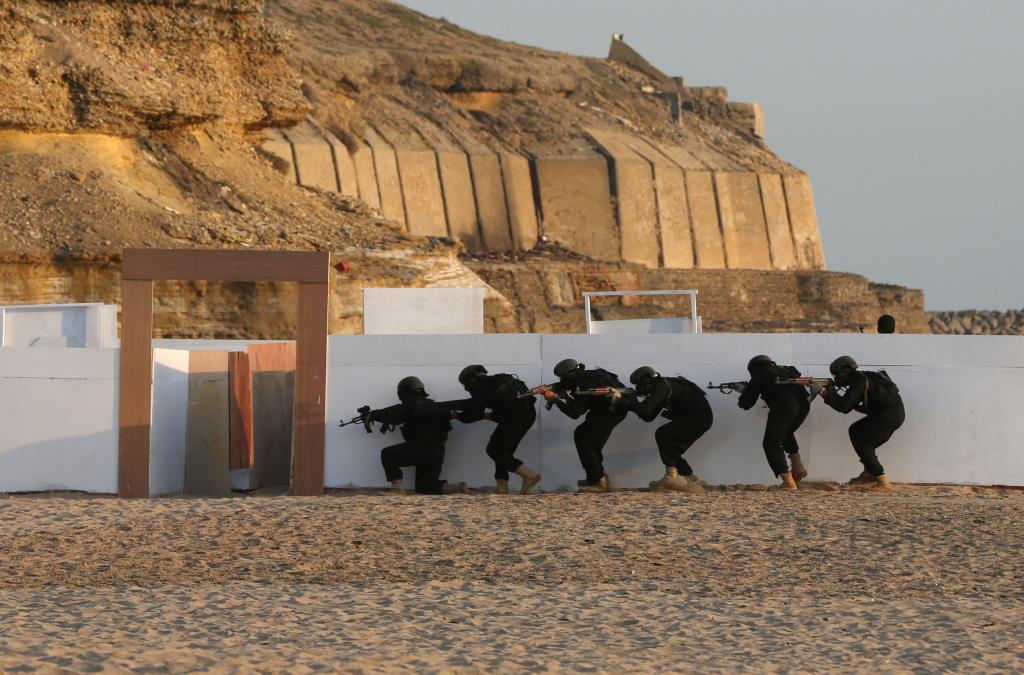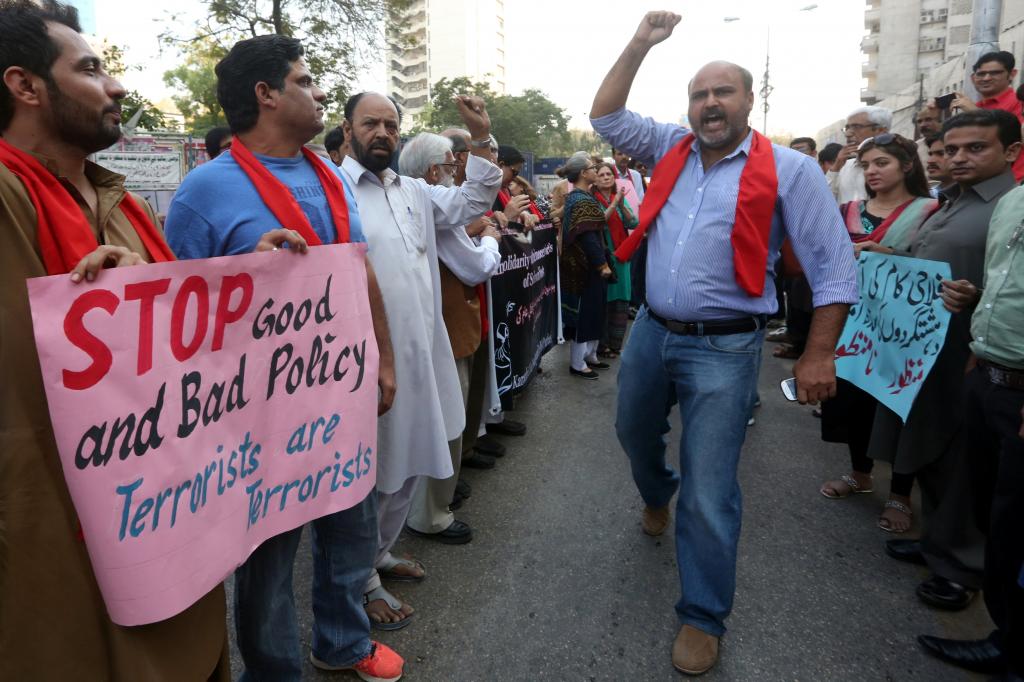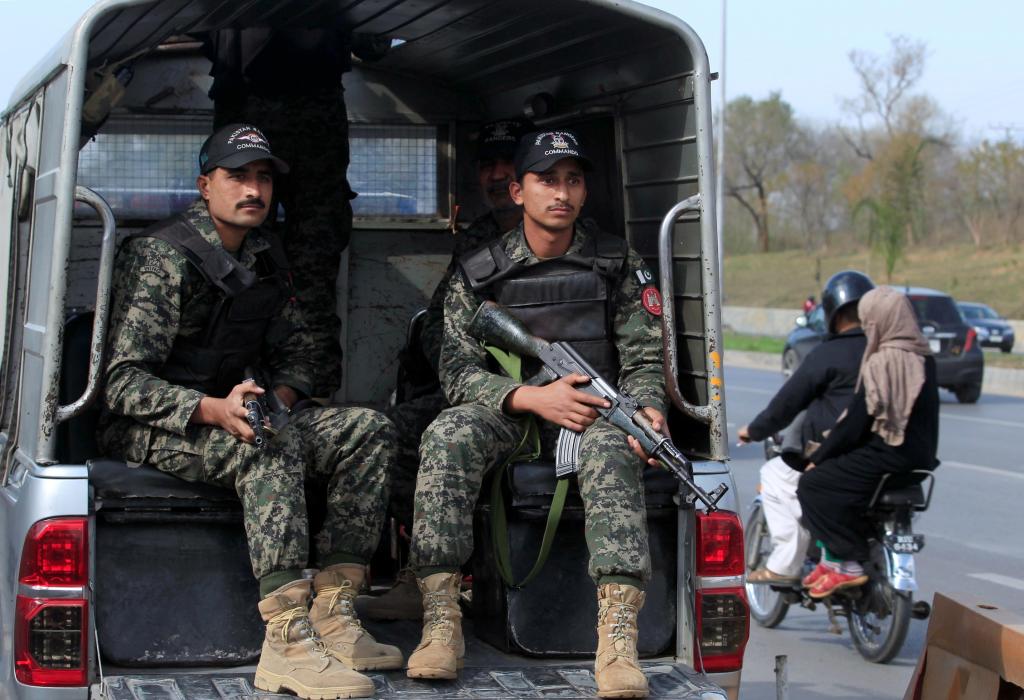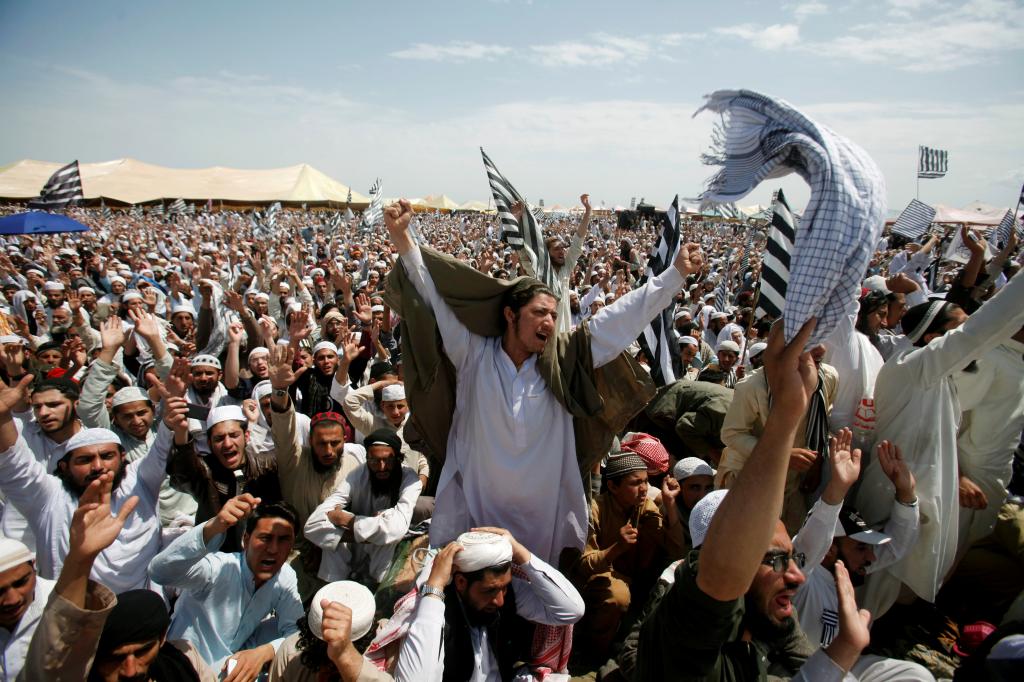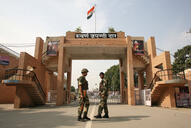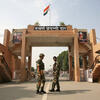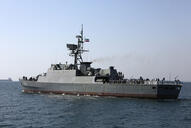At its founding in 1947, the culturally and religiously diverse state of Pakistan lacked a unifying force and was soon plunged into political turmoil. Successive governments crumbled as corruption and infighting weakened the central government, and provincial leaders retained the real power. In 1958, the Pakistani military launched its first coup and would centralize power over the next thirteen years, free from the need to maintain a governing coalition. Though the generals returned Pakistan to civilian rule in 1971, the country experienced two more periods of military rule from 1977 to 1988 and 1999 to 2007. Even during periods of civilian rule, when power would typically oscillate between the Muslim League and the Pakistan People’s Party, the military remained the de facto power broker, forging and dissolving alliances and governments however best suited its interests. As a result, of Pakistan’s twenty-nine prime ministers since independence, none have completed a full five-year term.
Separatist and extremist movements have exacerbated Pakistan’s struggle to achieve political stability. Among them, the most prominent today is the Tehrik-i-Taliban Pakistan (TTP), also known as the Pakistani Taliban for its links to the Afghan group. It was established in 2007 as a movement to unify Islamist militant organizations based mostly in the northwest border region, known as the Federally Administered Tribal Areas (FATA). The TTP arose to combat expanding Pakistani military operations [PDF] in FATA that began in 2002 after foreign militants fled to the area during the 2001 invasion of Afghanistan. Since then, the military has periodically launched major operations [PDF] against the TTP, but the militants have benefited from a porous border with Afghanistan and protection from the Taliban.
The TTP is highly decentralized, and its factions often disagree on policy, which has presented a challenge to the leadership, but its main objectives [PDF] have included fighting Pakistan’s security forces, resisting Western forces in Afghanistan, and implementing Sharia law in areas it controls. Leadership changes have also altered the TTP’s strategies; over time, it grew closer to al-Qaeda and, under Mullah Fazlullah’s leadership beginning in 2013, carried out increasingly deadly attacks. Though most attacks [PDF] occur in FATA and neighboring Khyber Pakhtunkhwa province, the TTP targets major cities throughout the country.
In June 2014, after former Prime Minister Nawaz Sharif’s efforts to negotiate a peace agreement with the TTP unraveled and militants attacked an international airport in Karachi, the government launched the Zarb-e-Azb Offensive against militant strongholds in North Waziristan. While effective, the operation displaced over a million people and cost billions of dollars. The TTP responded to the offensive with several attacks, including a December 2014 attack on the Army Public School in Peshawar that killed nearly one hundred fifty people, mostly schoolchildren, in the deadliest terrorist attack in Pakistan’s history.
In response, Pakistan’s political parties agreed on a comprehensive National Action Plan to combat terrorism and extremist ideology across the country, and Prime Minister Nawaz Sharif lifted a death penalty moratorium to allow the execution of convicted terrorists. After nearly two years, in June 2016, the Pakistani military declared that FATA had been cleared of militants. Nearly five hundred Pakistani soldiers died in the clearing operations, which killed roughly 3,500 militants. With support from U.S. drone attacks and militant infighting, Pakistan’s tactics succeeded in significantly weakening [PDF] the TTP from 2014 to 2018.
However, despite the government’s declaration of victory and a decline in the frequency of attacks, the TTP and other militants continued to operate and carry out major attacks. These included a March 2016 suicide bombing in a park in Lahore that targeted families celebrating Easter, killing almost seventy people and wounding over three hundred, and an August 2016 suicide bombing of a hospital in Quetta that targeted a gathering of lawyers, killing nearly seventy-five people and injuring at least one hundred.
The military is believed to have continued providing support to the Haqqani network, Lashkar-e-Taiba, and other militant proxy groups that often collaborate with the TTP. Furthermore, attacks claimed by the Islamic State have raised concerns over its growing presence and influence in Pakistan. Many of the militants fighting under the Islamic State’s banner in Afghanistan are believed to be former TTP militants who fled across the border, a phenomenon that has raised fears of an Islamic State-inspired campaign of violence inside Pakistan.
In July 2018, cricketer-turned-politician Imran Khan was elected prime minister in Pakistan's national elections. Khan received criticism for embracing controversial blasphemy laws, an issue pushed to the forefront of the election by the participation of several banned militant groups—including one led by Hafiz Muhammad Saeed, a designated global terrorist—operating as political parties to contest seats. The TTP targeted campaign rallies and polling places in the lead-up to the elections, including an attack in Mastung in July 2018 that killed more than one hundred forty people and wounded nearly two hundred others.
In June 2018, the leader of the TTP, Mullah Fazlullah, was killed in a drone strike in Afghanistan; Mufti Noor Wali Mehsud was named the new leader of the umbrella organization days later. This leadership change brought the Mehsud tribe back to the helm and sparked a reorientation of stated policy to reinvigorate the TTP. Specifically, the leadership has attempted to strengthen authority structures and redefine legitimate attack targets to reduce indiscriminate violence. Around the same time, Pakistan’s Khyber Pakhtunkhwa province approved a merger that stripped FATA of its autonomy, which sparked local resistance.
The security relationship between the United States and Pakistan also shifted in 2018, as the Donald J. Trump administration moved to suspend security assistance to Pakistan over a perceived continuing unwillingness to target militants who receive sanctuary in Pakistani territory and carry out attacks in Afghanistan. More than $800 million in security assistance was suspended or redirected that year, and the United States has cut off access for Pakistani military officers to U.S. military training and education programs in an effort to pressure the Pakistani government to change policy. The shift came as international pressure on Pakistan to tackle militancy and terrorism increased; in June 2018 the Financial Action Task Force placed Pakistan on the so-called “grey list” of countries not doing enough to stop money laundering and terrorist financing.
In August 2021, the Taliban’s return to power in Afghanistan gave the TTP a major boost. Despite Pakistani support for the Taliban during their decades of resistance, the Taliban has provided sanctuary for the TTP’s leadership and militants. Therefore, since 2021, the TTP has strengthened and used Afghanistan as a base for coordinating attacks in Pakistan. The Taliban offered to mediate but still refuses to force the TTP out. After failed negotiations, the TTP in April 2022 escalated attacks in a spring offensive called Operation Al-Badr, carrying out a record fifty-four attacks in one month.
In response, on April 21, 2022, Pakistan launched a slew of airstrikes on suspected TTP bases in Afghanistan but killed dozens of civilians in the process. The attack further strained relations between Pakistan and the Taliban and strengthened the negotiating position of the TTP. Sporadic peace talks [PDF] and ceasefire agreements have continued, but the TTP has little incentive to keep commitments unless the Taliban pressures them.
Overall, average TTP attacks per month increased from 14.5 in 2020 to 45.8 in 2022 and expanded in geographical scope, reflecting increased operability and improved weaponry acquired when the Afghan government collapsed. Furthermore, the TTP became more disciplined in its attacks to try to win public support; although suicide attacks increased, they only killed two Pakistani civilians in 2022.
Meanwhile, Pakistan plunged into a political crisis on April 3, 2022, when Prime Minister Imran Khan dissolved Parliament just before a no-confidence vote he was set to lose. He claimed the vote was a U.S.-led effort to oust him, but the Supreme Court overturned his decision and reinstated Parliament. Khan later reversed his claim of U.S. involvement. On April 10, the no-confidence vote passed, and Khan was removed as prime minister.
Khan and his Tehreek-e-Insaf (PTI) party called for nationwide demonstrations and threatened to march on Islamabad in support of early elections. In July 2022, he gained more momentum following a surprise landslide victory for his party in Punjab by-elections. The government then accused him of violating an anti-terror law; courts later ordered the charges dropped, but on October 21, 2022, Khan was banned from running for public office for five years on corruption charges. In late October, Khan led his supporters in a march on Islamabad, but he was shot in a failed assassination attempt on November 3. When the march failed to convince the government to hold early elections, Khan instructed the PTI-led Punjab and Khyber Pakhtunkhwa provincial assemblies to dissolve.
In March 2023, the media was barred from broadcasting Khan’s speeches. After the arrest of other key PTI members, an arrest warrant was issued for Khan and police raided his home in Lahore. The developments were met with protests and confrontations with police, and the warrant was rescinded. On May 9, Khan was arrested in court, and clashes between his supporters and police reignited. He was released on bail but now faces over one hundred criminal cases, which he says is an attempt by the military to neutralize him and his political party. Key PTI members have ditched the party, and the government has arrested thousands more, worsening Khan’s chances of a political return.
Khan formerly enjoyed close relations with the military; in fact, then-army chief Qamar Javed Bajwa’s support was key to his election as prime minister. Khan’s populist politics also attracted a wide base of public support. However, his relations with the military soured, and he blames Bajwa and current army chief Asim Munir for his ouster. Khan’s handling of the economy and foreign affairs, particularly relations with the United States, roiled the opposition. Khan’s critics also point out that despite running on an anti-corruption platform, corruption worsened under his tenure. Ultimately, Khan has polarized the political establishment and the country, managing to mount a greater resistance to the military than previous ousted politicians could.
Historically, Pakistan has only reluctantly cooperated with the United States in fighting terrorist groups, while simultaneously sponsoring U.S. adversaries like the Afghan Taliban and the Haqqani network. Now, with the Taliban back in control of Afghanistan, Pakistan has lost leverage over these groups, and the TTP is regaining strength. While the United States previously supported Pakistan’s efforts to root out the group by conducting airstrikes, the TTP now largely resides across the border in Afghanistan, making them harder to target. Though its current leadership denounces international ambitions, the TTP has previously threatened to attack the United States and other countries; in 2010 it claimed responsibility for a failed car bomb in New York City’s Times Square, and a change in leadership could see it regain those ambitions.
As the TTP expands in Pakistan and security deteriorates, separatist movements and other armed groups could regain strength. United or not, these groups present a major challenge to a cash-strapped Pakistani government. A destabilized Pakistan creates the risk for further proliferation of militant groups in the region and a greater risk of them holding territory and developing the capabilities to launch international terrorist attacks. Though the collapse of the Pakistani state remains unlikely, its nuclear arsenal remains vulnerable to attack or theft by nonstate actors, a major concern for U.S. and Indian policymakers.
In January 2023, a suicide bomber attacked a Peshawar mosque, killing at least one hundred people and wounding more than two hundred who had gathered to worship. The Jamaat-ul-Ahrar faction of the TTP initially claimed responsibility for the attack as a way to avenge Omar Khalid Khurasani, the group’s former leader who was killed in a roadside bombing in August 2022, but a TTP spokesperson has since denied their involvement. The leadership’s denial of responsibility indicates potential internal disagreements and increases the risk of violence against civilians by rogue factions.
The TTP has also expanded southward into Baluchistan, claiming to have partnered with two militant groups there. The expansion, along with continued attacks on Pakistani security forces, prompted Pakistan in April 2023 to announce a nationwide offensive to eradicate the militants. An operation of that scale has not occurred since 2014, when civilians became collateral damage. Furthermore, Pakistan now finds itself at risk of default, raising questions about how it will fund the effort. Pakistan is unlikely to fully defeat the TTP as long as the Taliban provides sanctuary, and in May 2023 Afghanistan pledged to step up cooperation on border security.
In the political realm, the Muslim League’s Shehbaz Sharif, brother of exiled politician Nawaz Sharif, succeeded Khan as prime minister. In May 2023, Khan and Shehbaz Sharif made progress in election negotiations, agreeing to hold national and provincial votes simultaneously. However, on August 5, authorities arrested Khan on corruption charges, disqualifying him from the upcoming electoral race and from holding office for the next five years. Days later, Pakistani officials approved the redrawing of electoral districts, which delayed elections originally due by November 2023 until February 2024. In the interim, Nawaz Sharif returned from self-imposed exile, and a court overturned a graft conviction against him, clearing the way for him to run for office.
Meanwhile, Pakistan is grappling with record inflation and ballooning unemployment, for which it no longer reports data. With foreign exchange reserves dwindling, Pakistan has become reliant on IMF bailouts and is increasingly at risk of default. The lack of job opportunities has contributed to a surge in outward migration, and in June 2023 over three hundred Pakistani migrants died trying to reach Europe when their boat sank off the coast of Greece. The dire economic situation has forced Pakistan to make difficult budgetary cuts and raise taxes to meet IMF demands, which could lead to public unrest.
Compounding Pakistan’s economic woes, climate change has increased the severity of natural disasters in the country, especially floods and heatwaves. In the summer of 2022, unrelenting rains flooded one-third of the country, with some areas receiving 450 percent of their normal rainfall, killing or injuring over fifteen thousand people and displacing eight million. Estimates of reconstruction costs and economic losses exceeded thirty billion dollars. The World Bank says that extreme weather events combined with pollution and environmental degradation could reduce Pakistan’s GDP by nearly twenty percent by 2050.
Finally, Pakistan announced in October that all undocumented foreigners must leave by November 1 or face deportation. The order applies to an estimated 1.7 million Afghans, many of whom fear persecution in Afghanistan and face harsh winter conditions and inadequate shelter if they return. By December, nearly half a million undocumented Afghans had left Pakistan for their home country. Pakistani officials have cited security concerns as one reason for the decision, claiming Afghans have perpetrated many of the country’s recent terrorist attacks.
